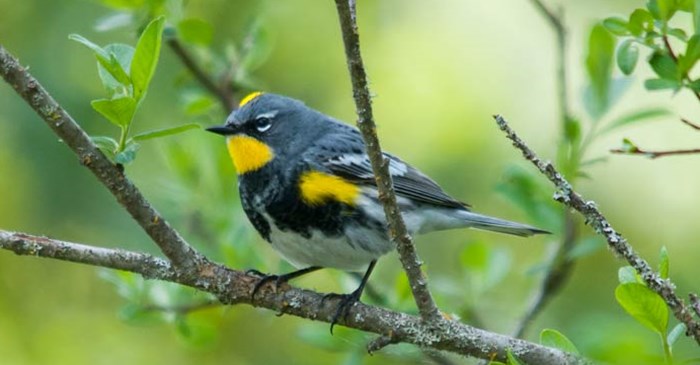Like other warblers, Yellow-rumped Warblers are small, colorful, insect-eating songbirds that whistle sweet songs. But unlike other warblers, these gray and yellow birds with the black eye mask do show up in backyards.
Depending on the time of year, they can be spotted just about anywhere in the lower 48 states and Alaska. In winter, they’re found in the southeastern U.S. and along the Pacific coast, foraging for berries in open habitat, including parks and residential areas. In the spring, they migrate to the pine forests of the Rocky Mountains, Appalachians and the northern reaches of the Midwest and New England as well as Canada. These birds travel in flocks, especially along the eastern coastline.
A tale of two species
At one time, the Yellow-rumped Warbler was considered two different species: the Myrtle Warbler, found in the eastern half of the U.S, and Audubon’s Warbler, found in the west. Where the throat of the Myrtle Warbler is white, the Audubon’s is golden yellow. Partly because they interbreed where their territories intersect in Canada, they were combined into one species in 1973.
However, in a report published in 2016, researchers found DNA evidence showing these are two distinct species after all. Despite that, the split has not been made official by the North American Classification Committee of the American Ornithologists’ Union. Not yet, anyway.
Feeding, nesting and backyard tips
The Yellow-rumped Warbler builds its nest high in the branches of a pine tree, anywhere from 4 to 50 feet off the ground. Females spend up to 10 days constructing the cup-like structure, occasionally accepting materials offered by the male. The nests are lined with animal hair and feathers, placed to curve upward over the cup to partially conceal the little eggs.
During the summer, their diet is focused solely on insects. The Yellow-rumped Warbler is quite versatile in its foraging methods. It can stand on a branch and catch bugs from the air while clinging to tree bark and it can skim water surfaces.
Warblers are known for spending winters in tropical locations. But what allows the Yellow-rumped Warbler to winter farther north is its ability to digest the wax in bayberries and wax myrtles — an ability not shared with other warblers. This warbler also eats berries of juniper, poison oak and Virginia creeper, along with seeds from goldenrod and beach grasses.
Another unique trait of Yellow-rumped Warblers is that they will visit backyard bird feeders. Lyric Fruit and Nut Mix features fresh sunflower seeds, raisins and peanuts of the highest quality, which will bring these warblers in for a landing.
